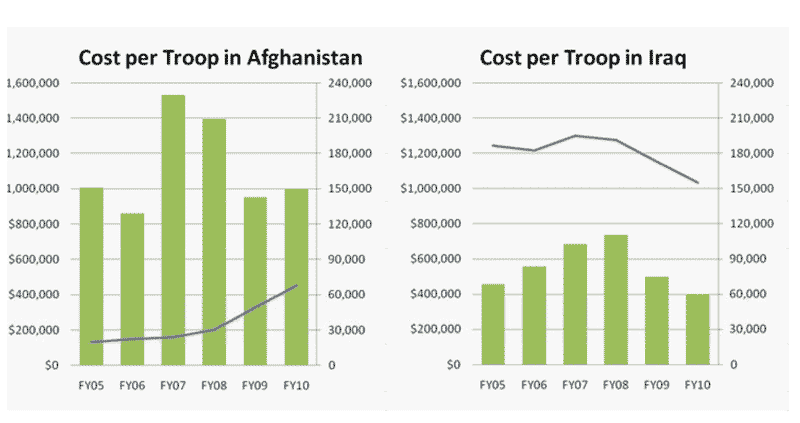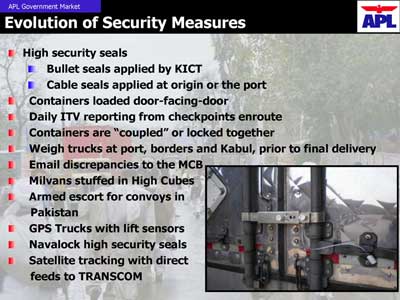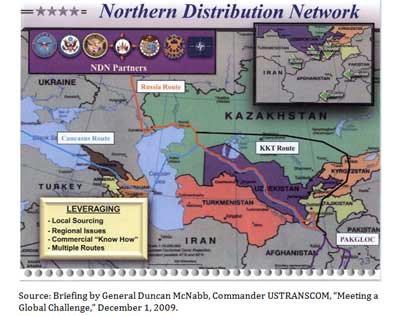A Surge in Cost Per Troop
The President has committed to a major new phase of the Afghan campaign. Although called a “surge,” it is much more of an expansion of the engagement. And with that expansion comes a significant demand for new resources to deal with the most neglected part of operations to the outsider, logistics and sustainment costs.
Afghanistan is not Iraq to quote General Petraeus. This is true in multiple ways, but no more so than in terms of operations and logistics. The geography and terrain in Afghanistan require what the USMC calls “distributed operations,” and with what the USMC calls “expeditionary logistics.” And such logistics require SIGNIFICANT use of air assets to connect deployed forces, and with those air assets significant energy and basing costs.
The cost for deployed soldier in Afghanistan will be multiples higher than for the deployed soldier in Iraq. Dependent on which analyst is doing the assessment, the number ranges from 2 to 4 times higher (see graphic below from CSBA Report, page 2).
Security Measures On the Move
Not only are direct costs significant, security considerations are as well. There are limited major airfields out of which to operate; these airfields provide targets for the use of bio or chemical weapons to disable those airfields. And providing security for goods in transit via the land routes is a major challenge as well (see briefing slides below from USCENTCOM presentation on the New Silk Road, pages 19 and 25).
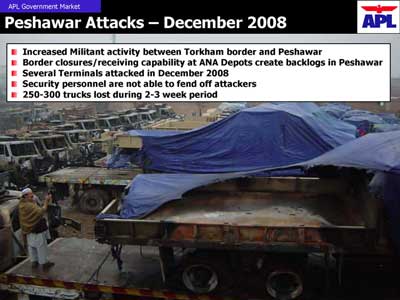
The Logistic Costs of Withdrawal and Recap
The “surge” carries with it a “withdrawal” imperative. This means that ramping up forces in country entails the very significant logistics costs of withdrawal as well. If we know anything from the experience of the current withdrawal from Iraq, logistics, even in the best of circumstances, costs tens of billions of dollars to execute for the withdrawal.
Of course, the “surge” is not just American. Allied engagement is inextricably intertwined with the Obama Administration allied policy. Logistics sustainment and supply in extreme environments and over significant distances will have to be performed for the coalition forces. And these efforts will operate from the same staging areas, whether air or ground basing.
Another cost to consider will be the ramp up of pressure to recapitalize the air infrastructure, which provides for the warfighter. Here the costs for modernizing C5s, adding C130s and C17s, the acceleration of the A400M, the rebuilding of the US tanker fleet, the entry of the new A330 allied tankers (UK and Australian tankers will arrive significantly before any new US tankers which are yet to be contracted, let alone procured) must be considered. The significant increase in air dropping required for Afghan operational support will require modernization of the fleet doing the air dropping.
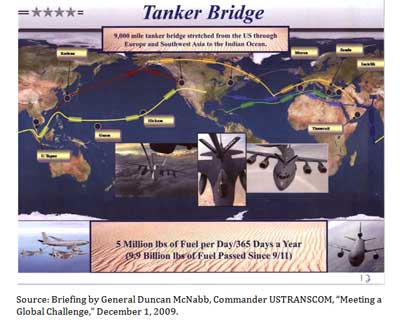
A Geopolitical Price to Pay
There will be significant geopolitical costs to logistics supply as well. The US and its allies will use land routes over Russian territory and are discussing the same with the Chinese. Some Americans have protested the proposed French sale of the Mistral ship to the Russians, but such activities might become more normal as costs are extracted by the Russians for support for the Afghan engagement. What we know about Russians is that their support is never free.
There has been a virtual war on contractors inside the beltway, which have provided for logistics support. This war will have to be ended and peace declared. Contracting support for the war will go up not down.
The variability of energy prices and currency fluctuations, generally, will be significant factors shaping the cost of operations as well. The general global economic dynamic will have a direct impact on the cost of the commodities used in the operation.
Rotorcraft investments are crucial to engage in this operation. The efforts to provide for enhanced improvements by NATO through collaborative maintenance of helos operating in Afghanistan is significant. Yet the acquisition of new birds will be necessary to support the effort and with these aircraft defense measures might well need to be funded as well.
Land-Locked or Dead-Locked Engagement ?
It is clear that simply to list the logistics imperatives underscores the high costs for the engagement. And if these costs are not paid for through significant defense supplementals, there will be a rapid contraction of the defense investment accounts. And these contractions will come at the expense of the global power projection capabilities already at risk in the department’s funding. The US could see a further shift from global presence to land-locked engagement.
These expenditures will be joined with the very significant costs of the Iraq withdrawal. This withdrawal will take at least two years.
So the challenge will be to provide logistics support for Iraq withdrawal, while the US and its allies are doing a significant ramp up and, if successful, followed by a ramp down in Afghanistan. If you want to follow the money in the US defense budget, you better look at logistics and its consequences for Afghanistan and Iraq. We are likely to see the Acquisition, Technology and Logistics department of the Pentagon become the Logistics, Acquisition support and Technology department and if they are not carefully the name will become LATE.
***
An earlier version of this piece appeared in DOD Buzz on December 11th, 2009.
———-
***Posted January 2nd, 2010


